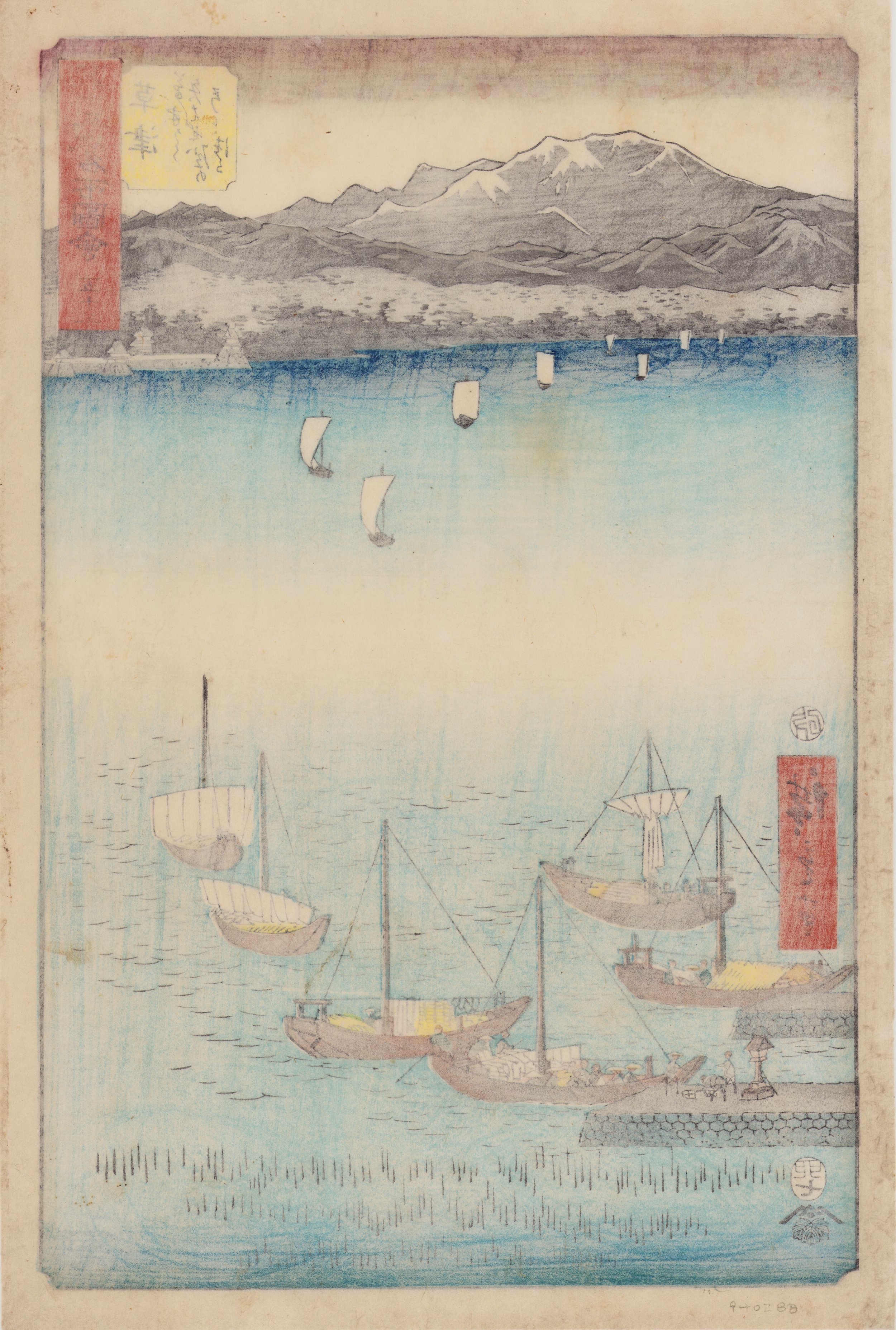Hiroshige | Kusatsu, Upright Tokaido
歌川広重 Utagawa Hiroshige (1797-1858)
五十三次名所图绘 草津
Kusatsu, from the series of Pictures of Famous Places of the 53 Stations
1855
木版画 | 纵绘大判 | 36cm x 25cm
Woodblock-print | Oban tate-e | 36cm x 25cm
早期版次;品相非常好
Early impression; very good condition
SOLD
《五十三次名所图会》,是广重在1855年创作的,一套以东海道五十三次为题材的风景版画。在此系列中,广重一改往日的横绘,首次使用了纵向构图的竖绘。通常而言,纵向构图的风景画能强化垂直景物的存在感,并通过明显的画面纵深,表现出景别由近及远的节奏感,增强观赏者对画面的场景体验,有着横向构图难以达到的独特张力。草津宿,东海道五十三次中的第52处宿场,位于今滋贺县草津市市街。由于地处东海道与中山道的交汇点,此地自古以来就是东西往来的重要交通枢纽,其内的本阵至今尚存,已被指定为国家史迹。白帆片片,从对岸琵琶湖的大津一侧向切近驶来。相比距离长远且难行的陆路,往返草津与大津两地的人们更多选择了这条穿越琵琶湖的水路航线,平缓、便捷且风光无限。正如中国潇湘八景中有远浦归帆,近江八景之一的矢桥归帆,也即画中这番景象。由远及近的渡船从扬帆到鼓帆再到收帆,一幕幕相连,如同极为流畅的动画,在画框中不断播放。若能乘风鸟瞰,便可见琵琶湖的湖岸线圆弧似弓,相连一线的归帆作弓弦之势。广重仅凭画题,就给了我们另一个浪漫的想象。
Interested in purchasing?
Please contact us.
歌川広重 Utagawa Hiroshige (1797-1858)
五十三次名所图绘 草津
Kusatsu, from the series of Pictures of Famous Places of the 53 Stations
1855
木版画 | 纵绘大判 | 36cm x 25cm
Woodblock-print | Oban tate-e | 36cm x 25cm
早期版次;品相非常好
Early impression; very good condition
SOLD
《五十三次名所图会》,是广重在1855年创作的,一套以东海道五十三次为题材的风景版画。在此系列中,广重一改往日的横绘,首次使用了纵向构图的竖绘。通常而言,纵向构图的风景画能强化垂直景物的存在感,并通过明显的画面纵深,表现出景别由近及远的节奏感,增强观赏者对画面的场景体验,有着横向构图难以达到的独特张力。草津宿,东海道五十三次中的第52处宿场,位于今滋贺县草津市市街。由于地处东海道与中山道的交汇点,此地自古以来就是东西往来的重要交通枢纽,其内的本阵至今尚存,已被指定为国家史迹。白帆片片,从对岸琵琶湖的大津一侧向切近驶来。相比距离长远且难行的陆路,往返草津与大津两地的人们更多选择了这条穿越琵琶湖的水路航线,平缓、便捷且风光无限。正如中国潇湘八景中有远浦归帆,近江八景之一的矢桥归帆,也即画中这番景象。由远及近的渡船从扬帆到鼓帆再到收帆,一幕幕相连,如同极为流畅的动画,在画框中不断播放。若能乘风鸟瞰,便可见琵琶湖的湖岸线圆弧似弓,相连一线的归帆作弓弦之势。广重仅凭画题,就给了我们另一个浪漫的想象。
Interested in purchasing?
Please contact us.
歌川広重 Utagawa Hiroshige (1797-1858)
五十三次名所图绘 草津
Kusatsu, from the series of Pictures of Famous Places of the 53 Stations
1855
木版画 | 纵绘大判 | 36cm x 25cm
Woodblock-print | Oban tate-e | 36cm x 25cm
早期版次;品相非常好
Early impression; very good condition
SOLD
《五十三次名所图会》,是广重在1855年创作的,一套以东海道五十三次为题材的风景版画。在此系列中,广重一改往日的横绘,首次使用了纵向构图的竖绘。通常而言,纵向构图的风景画能强化垂直景物的存在感,并通过明显的画面纵深,表现出景别由近及远的节奏感,增强观赏者对画面的场景体验,有着横向构图难以达到的独特张力。草津宿,东海道五十三次中的第52处宿场,位于今滋贺县草津市市街。由于地处东海道与中山道的交汇点,此地自古以来就是东西往来的重要交通枢纽,其内的本阵至今尚存,已被指定为国家史迹。白帆片片,从对岸琵琶湖的大津一侧向切近驶来。相比距离长远且难行的陆路,往返草津与大津两地的人们更多选择了这条穿越琵琶湖的水路航线,平缓、便捷且风光无限。正如中国潇湘八景中有远浦归帆,近江八景之一的矢桥归帆,也即画中这番景象。由远及近的渡船从扬帆到鼓帆再到收帆,一幕幕相连,如同极为流畅的动画,在画框中不断播放。若能乘风鸟瞰,便可见琵琶湖的湖岸线圆弧似弓,相连一线的归帆作弓弦之势。广重仅凭画题,就给了我们另一个浪漫的想象。
Interested in purchasing?
Please contact us.
Utagawa Hiroshige (1797-1858)
Ando Hiroshige (1897-1858) revolutionized the art of landscape prints during the Edo era, building on the success of his senior, Hokusai, but taking a more poetic and naturalist approach to portraying the beauty of Japan.
The son of a low-level Samurai assigned to the fire brigade in Edo, Hiroshige became a student of the Utagawa school as a young man. His first prints focused on beautiful women (bijin), and views of Edo. But in 1833 he began work on his most famous early work, his first series depicting the Tokaido, the "Great Sea Road" between Edo and Tokyo.
Today there is some controversy about this series. Initially, it was believed that Hiroshige had travelled the route along with a local lord (Daimyo) who was making a gift of horses to the Emperor. But more recent scholarship suggests Hiroshige never travelled the road himself, at least not the entire way, and made his designs using published guidebooks.
Nonetheless, the prints were wonderful and revolutionary. They embraced the seasons with a gentle lyricism missing from Hokusai's striking but stylized depictions. In Hiroshige's work, nature is sacred -- but it is always mixed with humanity, with travelers or little inns or bridges. There is a magical harmony between man and the elements.
His depiction of the seasons and weather is especially evocative. Snow blankets some views with a hushed silence, while rain streaks down furiously in others. In some prints natured is agitated; in others, calm prevails. Produced in a horizontal oban yoko-e format, the series was a smash hit.
The Tokaido series made Hiroshige famous, and he became incredible prolific. In the 1840s he produced many strong designs, but many mediocre ones, too, including several subsequent Tokaido series of varying quality.
In 1853, however, he made a big step. He turned his landscapes sideways, embracing a bold vertical oban tate-e format. This gave his designs new energy and a modern feel. The first of these was Famous Views of the Sixty-Odd Provinces. From them on, most of his most noted series were executed in this format.
He saved his greatest for his last. In 1856 he began work on 100 Famous Views of Edo, which many consider his most exceptional work. Here his home city was portrayed with energy and passion, and in these 119 designs he created an incredible record of a vanished place. In addition to the striking vertical format, he developed exciting new compositions, often juxtaposing a strong foreground element with a distant background.
Among the many famous images in this series are Squall at Ohashi and the Plum Garden in Komeido. Both of these were copied by Vincent Van Gogh, a great admirer of Hiroshige. Thus, the great Japanese artist had a profound effect on Western art.
Alas, his beloved Edo ended his life. Hiroshige was claimed by a cholera epidemic that swept the city in 1958. His pupil Shigenobu, who took the name Hiroshige II, completed The Famous Views of Edo.


